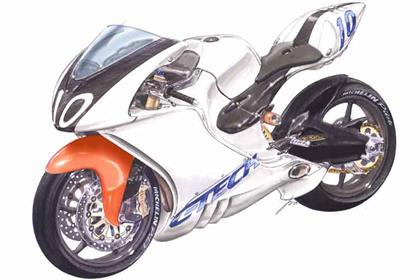Carbon-fibre bikes – a potted history
This official drawing shows how British firm C-Tech, which supplies bodywork to superbike teams, is developing a carbon chassis to suit the latest generation of inline four-cylinder engines.
But the C-Tech bike is not the first carbon-fibre motorcycle. Below is a short list of other bikes which have used carbon-fibre.
Cagiva C194
Back in 1994 Cagiva’s C194 500cc two-stroke pioneered a carbon-fibre chassis, using a beam frame that was half conventional alloy, half carbon fibre. The bike’s carbon frame really used traditional techniques more suited to an alloy design, and it wasn’t a success, only racing twice before the firm reverted to a conventional aluminium beam chassis.
Britten
The Britten story has become a legend, and it was one of the first bikes ever to use carbon fibre as a real structural component in the early 1990s. However, the majority of its chassis strength came not from the carbon fibre, but from the structural engine. In fact, it had virtually no traditional frame at all.
Lotus prototype
By far the closest design to C-Tech’s concept, the planned Lotus superbike, which was seriously considered by the Norfolk firm in the late 1990s, used a carbon-fibre monocoque designed by legendary racer and engineer Peter Williams.
Based, like the C-Tech, around an eggshell design, it was split vertically down the middle rather than horizontally, and retained an aluminium section to hang the engine from, with the bolt-on carbon-fibre sides providing the bike’s rigidity.
Although ditched by Lotus, Williams continues to pursue the concept, and is trying to get the original prototype built into a running machine to prove his idea works.
Ducati Desmosedici GP9
The latest machine to bring carbon fibre’s potential as a chassis material into the spotlight, the GP9 is more like the Britten in its design – with virtually no frame at all.
The engine provides the majority of the strength, with just a small carbon bracket at the top to attach the headstock. Although not a real carbon frame, if successful the bike will go some way to dispelling preconceptions that a metal frame is vital to allow a chassis to flex; its engine won’t flex at all and the small carbon section will provide all the give needed to control chatter.
Motoczysz C1
Although yet to prove itself in competition, the radical Motoczysz C1 has received glowing reports from testers such as Jeremy McWilliams.
Using a structural engine and a semi-monocoque carbon frame as well as a carbon swingarm, Motoczysz’s concept is to provide flex in the front suspension rather than the chassis, with a patented flexible fork design to control chatter.
Although it’s still not clear quite what Motoczysz plans to do with the bike – the 990cc C1 prototype isn’t eligible for any significant race series – the firm has said it’s working on a 600cc interpretation of the idea, which might make it an ideal GP2 candidate, although rumoured cashflow problems at the US company could end the project before it even gets off the ground.


